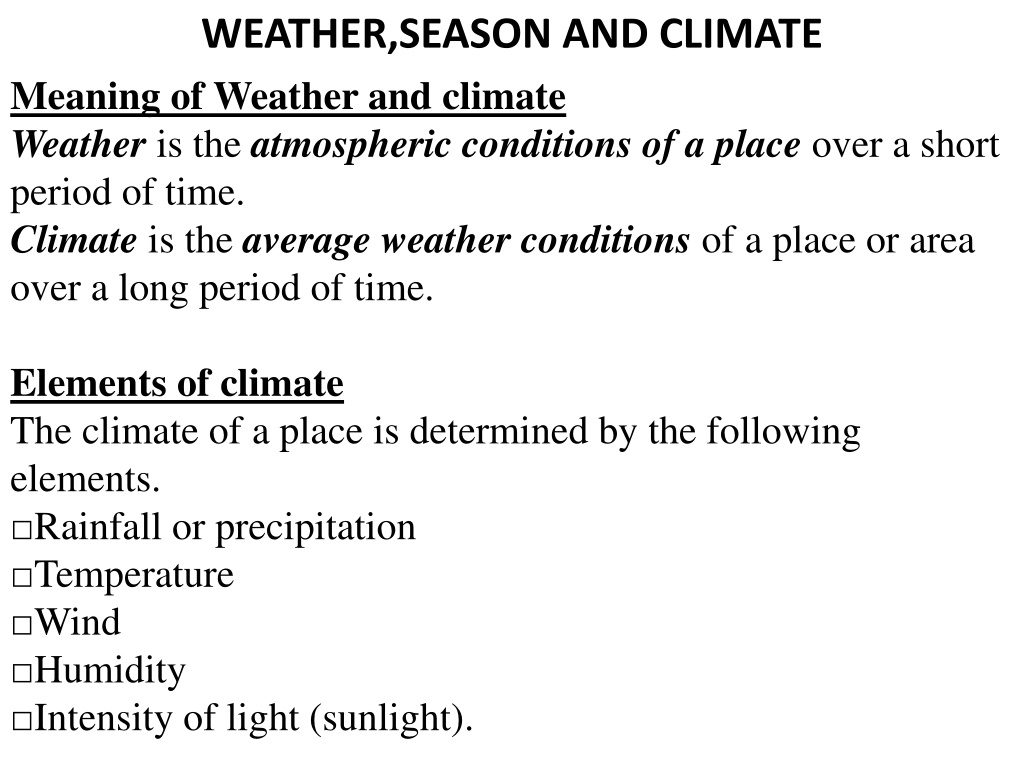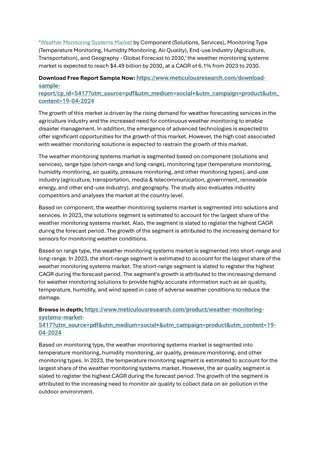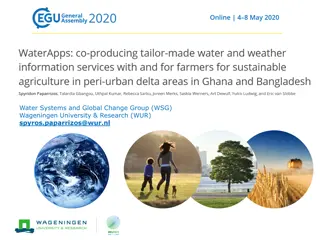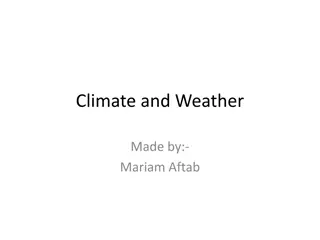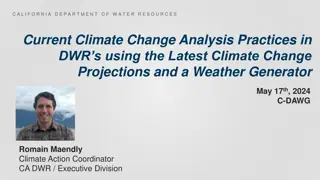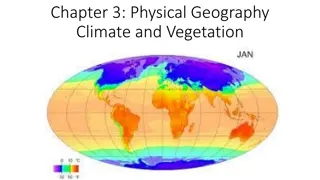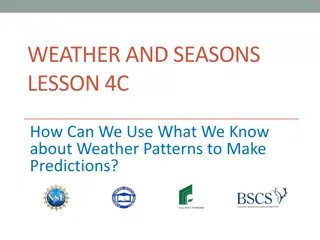Understanding Weather, Season, and Climate
Weather refers to short-term atmospheric conditions, while climate represents long-term average weather patterns. Elements like rainfall, temperature, wind, humidity, and sunlight influence climate. Rainfall affects agriculture, with both excess and insufficient rainfall having negative impacts. Temperature is a measure of hotness or coldness, crucial for various aspects of life and environment.
Download Presentation

Please find below an Image/Link to download the presentation.
The content on the website is provided AS IS for your information and personal use only. It may not be sold, licensed, or shared on other websites without obtaining consent from the author. Download presentation by click this link. If you encounter any issues during the download, it is possible that the publisher has removed the file from their server.
E N D
Presentation Transcript
WEATHER,SEASON AND CLIMATE Meaning of Weather and climate Weather is the atmospheric conditions of a place over a short period of time. Climate is the average weather conditions of a place or area over a long period of time. Elements of climate The climate of a place is determined by the following elements. Rainfall or precipitation Temperature Wind Humidity Intensity of light (sunlight).
WEATHER,SEASON AND CLIMATE Weather Season - It varies daily It lasts for about 3 or 4 months - It is short term phenomenon It is long term phenomenon - It covers relatively small areaCover large area - It is measurable Not measurable -Not influenced by distance from the sun Influenced by distance from the sun
WEATHER,SEASON AND CLIMATE Weather Season - It varies daily It lasts for about 3 or 4 months - It is short term phenomenon It is long term phenomenon - It covers relatively small areaCover large area - It is measurable Not measurable -Not influenced by distance from the sun Influenced by distance from the sun
WEATHER,SEASON AND CLIMATE Rainfall / precipitation It is the amount of moisture or water vapour that condenses and falls to the ground.The instrument used for measuring rainfall is the rain gauge. Rainfall has a direct effect on agriculture produce (plants and animals growth).
WEATHER,SEASON AND CLIMATE Effects of rainfall on agriculture: 1. High or heavy rainfall can cause farmland to get flooded and in the process leading to erosion, leaching and destruction of farm crops. 2. It also destroys living place (habitat) for living organisms in the soil. 3. Lowrainfall or inadequate rainfall on the other hand causes low food production. 4. It also causes water bodies such as lakes, rivers etc to dry up leading to death of aquatic living organisms. 5. Low rainfall also results in drought. 6. For these reasons a good amount of rainfall is needed for the proper growth and development of crops.
WEATHER,SEASON AND CLIMATE What is temperature? It is the measure of the degree of hotness or coldness of a body or environment, or lt is the degree of hotness or coldness of the atmosphere at a particular time. The instrument used in measuring temperature is the thermometer. It is measured in degree Celsius ( C) or Fahrenheit.
WEATHER,SEASON AND CLIMATE Effects of temperature on agriculture 1. If the temperature is too high, it increases the rate of water loss in plants and animals which affects their growth. 2. High temperature affects the absorption of nutrients from the soil by plants. 3. High temperature also causes bush fires which could lead to the destruction of the natural vegetation and the ecosystem. 4. High temperature also causes organic matter to decay faster, releasing nutrients into the soil for plant growth. 5. However, if the temperature is low, it slows down the growth and other activities of organisms.
WEATHER,SEASON AND CLIMATE What is wind? It is the movement of air in the atmosphere. The speed of the wind is measured with an instrument known as the anemometer whilst the direction of the wind is measured with an instrument known as the wind vane.
WEATHER,SEASON AND CLIMATE Effects of wind on agriculture 1. Wind enhances dispersal of fruits and seeds in plants. 2. Strong wind causes soil erosion and also affects agriculture productivity. 3. Strong wind uproots and destroys food crops on the farm. 4. Strong wind drives away animals in their natural home. 5. Strong wind increases the rate of water loss in plants. 6. Wind promotes pollination in some flowering plants.
WEATHER,SEASON AND CLIMATE What is humidity? It is the amount of water vapour in the atmosphere. Relative humidity on the other hand is the measure of the amount of water vapour in the atmosphere. Low or high humidity depends on the temperature in the atmosphere. This means that, the higher the temperature, the lower the humidity. The instrument used to measure the amount of water vapour in the air is the hygrometer.
WEATHER,SEASON AND CLIMATE Effects of Humidity on Agriculture 1. High humidity reduces the rate of water loss from plants and animals. 2. High humidity promotes plant and animal growth. 3. High humidity causes food stuffs to rot quickly. 4. It also increases the spread of diseases in plants and animals.
WEATHER,SEASON AND CLIMATE Intensity of light. It refers to the amount of sunlight that reaches plants and animals in their habitat. Intensity of light (sunlight) affects green plants to a greater extent than animals. This is because green plants depend on sunlight to prepare their own food (photosynthesis).Animals also depend on the prepared food for their survival. The instrument used to measure the intensity of light is the photometer.
WEATHER,SEASON AND CLIMATE Effects of intensity of light on agriculture. Light intensity provides energy for photosynthesis in plants. Too much sunlight also affects the growth of plants. It also affects the distribution of plants and animals species growing at different depth in water bodies.
WEATHER,SEASON AND CLIMATE Differences between weather and climate 1. Weather takes a short time to change but climate takes very long time to change. Weather can be predicted within 24hours but climate can only be predicted after one year. 2. Weather is also used to determine a short term activities like fishing and drying of food substances but climate is used to determine long term activities like farming and road construction.
WEATHER,SEASON AND CLIMATE Cyclic nature of weather and climate Weather and climate change do occur in a form of cycle. For example: every year, between December and March we enter into harmattan period. Between April to June and from September to November we also enter into two rainy seasons which occur especially in the southern part of the country every year. In our daily lives, at times the weather can be hot or sunny today and the next day or few days it changes again to become windy, rainy or cloudy.
WEATHER,SEASON AND CLIMATE Cyclic nature of weather and climate This is simply because, weather and climate are related. When the weather in a particular area changes over a long period of time, the climate also changes due to the activities of man such as industrialization, farming, bush burning etc which is causing the depletion of the ozone layer. Weather and climate are increasingly changing which is having negative effect on plants, animals and the environment as a whole.
WEATHER,SEASON AND CLIMATE Effects of weather and climate change on the environment. 1. Flooding: It occurs due to the occurrence of heavy rainfall as the warmer temperature speed up the water cycle. 2. Increasing amount of drought: This occur due to very high temperature and very low amount of rainfall which leads to a high rate of evaporation and very dry weather condition. 3. Changes in the conditions of the ecosystem: As the temperature becomes high, it disturbs the plants and animals in their natural home. Some animals and plants species may migrate to cooler places or even die. 4. Rising sea levels: As the climate warms ice berg in the Polar Regions, the earth melts which is caused as a result of global warming?. As it melts it causes the expansion of the sea water. The expansion of the sea water threatens
WEATHER,SEASON AND CLIMATE Examples of incidences of weather and climatic changes in Ghana and their effect on the environment. The 1983 drought in Ghana: During the year 1983, rains had totally failed to fall for sometime which has lead to a severe and prolonged drought throughout the nation. Most water bodies got dried as a result of high rate of water loss which has also affected economic activities such as fishing. Atmospheric temperatures became very high which caused most plants to dry out as a result of low rate of humidity and high rate of evaporation.
WEATHER,SEASON AND CLIMATE Examples of incidences of weather and climatic changes in Ghana and their effect on the environment. The incident also disturbed the ecosystems: Pants and animals in their natural home died because there was scarcity of food and water for animals to depend on. The forest and grassland were all affected by bush fires because of the dry weather conditions. The greatest effect during this incidence was shortage of food which has lead to severe famine throughout the whole nation.
WEATHER,SEASON AND CLIMATE Ghana meteorological services Ghana meteorological services department is the agency responsible for providing weather and climatic information to the general public on daily bases. Role of Ghana meteorological service department: 1. They provide weather forecast on daily basis either on radio or television set. 2. They collect, process, store and make known meteorological information. 3. They also provide meteorological information to meet international standard
WEATHER,SEASON AND CLIMATE Meteorology, meteorologist and meteorological station. Meteorology is the scientific study of the weather and the atmosphere. These include the study of changes in temperature, air pressure, moisture and wind direction. Meteorologist is a person who studies the weather. Meteorological station is a place where the meteorologist work and take records on the weather forecast. At the meteorological station, the meteorologist uses computers and other weather measuring equipment's such as Rain gauge, Thermometer, Barometer, Hygrometer, Wind Vane etc to study and taking records of the weather conditions.
WEATHER,SEASON AND CLIMATE Weather measuring equipment in the meteorological station. Rain gauge: It is an equipment used to measure the amount of rainfall or precipitation. It measures rainfall in millimeters or inches. funnel
WEATHER,SEASON AND CLIMATE Weather measuring equipment in the meteorological station. Thermometer Thermometer: It is also used to measure the temperature of the atmosphere of an area. The temperature of the atmosphere can be measured in Kelvin (K). The maximum and the minimum thermometer are mostly used for measuring the highest and lowest temperature. The minimum thermometer records the lowest temperature and the maximum thermometer also records the highest temperature.
WEATHER,SEASON AND CLIMATE Weather measuring equipment in the meteorological station. The maximum and the minimum thermometer
WEATHER,SEASON AND CLIMATE Weather measuring equipment in the meteorological station. Barometer: It is an equipment used to measure the atmospheric pressure. It is measured in Pascal (pa). An example of barometer is the aneroid barometer.
WEATHER,SEASON AND CLIMATE Weather measuring equipment in the meteorological station. Hygrometer: It is an instrument used to measure the amount of water vapour in the air (humidity) caused by condensation and evaporation. The most common type of hygrometer is the wet and the dry bulb hygrometer which is used to determine the humidity in the atmosphere. The wet bulb measures the water vapour in the atmosphere whilst the dry bulb also measures the temperature of the atmosphere. The difference between the two readings on the wet and dry bulb becomes the humidity of the atmosphere. But when the reading is expressed as a percentage, it becomes relative humidity.
WEATHER,SEASON AND CLIMATE Weather measuring equipment in the meteorological station. wet and dry bulb hygrometer
WEATHER,SEASON AND CLIMATE Weather measuring equipment in the meteorological station. Anemometer Anemometer: It is an equipment used to measure the speed of the wind which is recorded in knots. Anemometer
WEATHER,SEASON AND CLIMATE Weather measuring equipment in the meteorological station. Wind Vane Wind Vane. It is also used to measure the direction of the wind.
WEATHER,SEASON AND CLIMATE Weather measuring equipment in the meteorological station. Sun dial :It is a device that measures time by the position of the sun. sunshine recorder: It is used to record the amount of sunshine at a given location. Weather Satellite: lt is a type of satellite used to provide information on weather conditions in the upper part of the atmosphere.
WEATHER,SEASON AND CLIMATE Weather chart Weather chart is the summary of the weather conditions at a given time and over an extended region. Locality Temperature (oC) Humidity Jan. 27 56 Feb. 28 53 Mar. 29 50 Apr. 30 40 May. 32 70 Jun. 22 80 Jul. 21 90 Aug. 19 88 Sept. 24 85 Oct. 16 90 Nov. 17 75
WEATHER,SEASON AND CLIMATE Climate and the various vegetation zones in Ghana Vegetation zones in Ghana can be divided into six zones namely; Key 1. Tropical rainforest 2. Rain forest 3. Guinea savanna 4. Sudan savanna 5. Coastal scrub and grassland 6. Strand and mangrove
WEATHER,SEASON AND CLIMATE Tropical Rain forest: This type of vegetation receives the highest amount of rainfall with virtually no dry season. The trees in this area are very dense with little air circulation and penetration of light.Due to the continues growth and dense nature of trees in this region ,the trees form three distinctly ers each forming a canopy. This type of vegetation is found in the western region.Plants such as cocoa,oil palm and rubber do well in this region.
WEATHER,SEASON AND CLIMATE Rain Forest: This vegetation is found in the Ashanti, Brong Ahafo as well as parts of the Eastern, Volta, Central and Western Regions. This area receives high amount of rainfall with a very short dry season.This area supports very tall trees such as the mahogany, odum, sapele etc. which are used for timber. The area also supports plantation crops such the cocoa, oil palm etc.
WEATHER,SEASON AND CLIMATE Guinea Savanna: This vegetation can be found in the three Northern Regions of Ghana and is similar to the coastal savanna. Because of the low rainfall, it supports the growth of grass, making it suitable for the grazing of livestock. It also supports tall trees like the silk, cotton and baobab. Crops such as groundnuts, yam, millet and sorghum also does well in this area.plantation crops such the cocoa, oil palm etc.
WEATHER,SEASON AND CLIMATE Sudan Savanna: It is a region with a very long period of dry season and has a rainfall average between 500 and 1000mm per year. It is a region with a very hot weather and vegetation of short grasses with dispersed thorny bushes. The Sudan Savanna is also prone to over grazing because cattle are the major animals reared in this region.
WEATHER,SEASON AND CLIMATE Coastal Savanna: This area receives low rainfall. This type of vegetation is found along the coast in what has been called the coastal plains which stretch from the Volta Region to Winneba in the Central Region. Because of the low rainfall, this area support mainly grass which is suitable for grazing livestock such as cattle, goats and sheep. The area is also free of tsetse flies, which are vectors of a disease called trypanosomiasis. Trypanosomiasis is caused by trypanosoma and transmitted by tsetsefly.
WEATHER,SEASON AND CLIMATE Strand and Mangrove: It is found along the coastal areas of Ghana. The plants that can grow in this area are generally tolerant of salinity and water logging. However plants such as the mangrove which has got special characteristics are able to do well in this area. The mangrove plants have modified roots and form supports called stilts.
